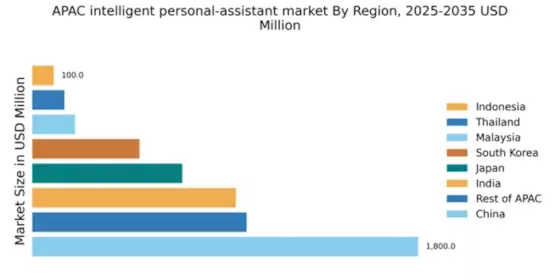China : Unmatched Growth and Innovation
China holds a commanding market share of 36% in the intelligent personal-assistant sector, valued at $1800.0 million. Key growth drivers include rapid urbanization, increasing smartphone penetration, and a tech-savvy population. Government initiatives like the "Made in China 2025" policy promote AI development, while robust infrastructure supports tech startups. Demand for smart home devices and AI applications in various sectors is surging, reflecting changing consumption patterns.
India : Emerging Market with High Potential
India's intelligent personal-assistant market is valued at $950.0 million, capturing 19% of the APAC market. The growth is fueled by increasing internet accessibility, a young demographic, and rising disposable incomes. Government initiatives like Digital India aim to enhance digital infrastructure, while the demand for voice-activated services is on the rise, particularly in urban areas. Consumption patterns are shifting towards AI-driven solutions in education and healthcare.
Japan : Mature Market with Unique Needs
Japan's market for intelligent personal assistants is valued at $700.0 million, representing 14% of the APAC share. The growth is driven by a high adoption rate of smart devices and a strong focus on robotics and AI. Government policies support innovation in technology, while consumer preferences lean towards privacy and security. The demand for AI in sectors like healthcare and automotive is increasing, reflecting unique consumption patterns.
South Korea : A Leader in AI Solutions
South Korea's intelligent personal-assistant market is valued at $500.0 million, accounting for 10% of the APAC market. The growth is propelled by high smartphone penetration and a tech-savvy population. Government initiatives promote AI research and development, while demand for smart home devices is rising. Cities like Seoul and Busan are key markets, with major players like Samsung leading the competitive landscape in AI applications across various sectors.
Malaysia : Emerging Market with Opportunities
Malaysia's market for intelligent personal assistants is valued at $200.0 million, capturing 4% of the APAC share. The growth is driven by increasing smartphone usage and government initiatives like the Malaysia Digital Economy Blueprint. Demand for AI in sectors such as e-commerce and customer service is rising, reflecting changing consumption patterns. The competitive landscape includes local startups and international players, creating a dynamic business environment.
Thailand : Market with Diverse Applications
Thailand's intelligent personal-assistant market is valued at $150.0 million, representing 3% of the APAC market. The growth is supported by increasing internet penetration and a young population eager for technology. Government initiatives like the Thailand 4.0 policy aim to boost digital innovation. Key cities like Bangkok are central to market dynamics, with major players focusing on AI applications in tourism and retail sectors.
Indonesia : AI Solutions Gaining Traction
Indonesia's market for intelligent personal assistants is valued at $100.0 million, accounting for 2% of the APAC share. The growth is driven by rising smartphone adoption and a young, tech-savvy population. Government initiatives to improve digital infrastructure are crucial for market expansion. Key cities like Jakarta are pivotal, with local and international players competing in sectors like e-commerce and finance, reflecting diverse consumption patterns.
Rest of APAC : Opportunities Across the Region
The Rest of APAC market for intelligent personal assistants is valued at $1000.0 million, capturing 20% of the overall market. Growth is driven by varying levels of technology adoption and government support across countries. Demand for AI solutions in sectors like finance, healthcare, and education is increasing. The competitive landscape includes both local startups and established international players, creating a dynamic environment for innovation and growth.



















Leave a Comment